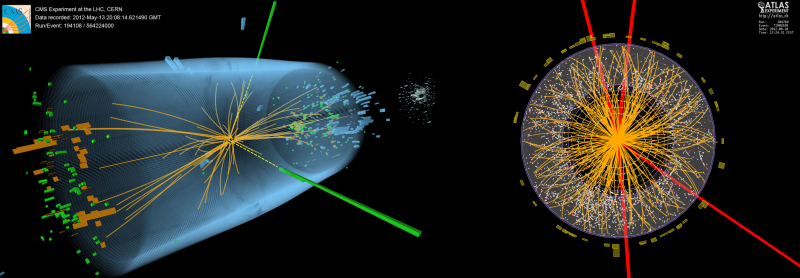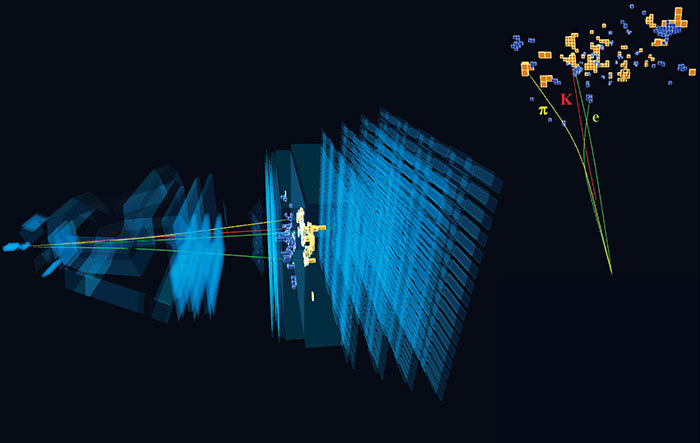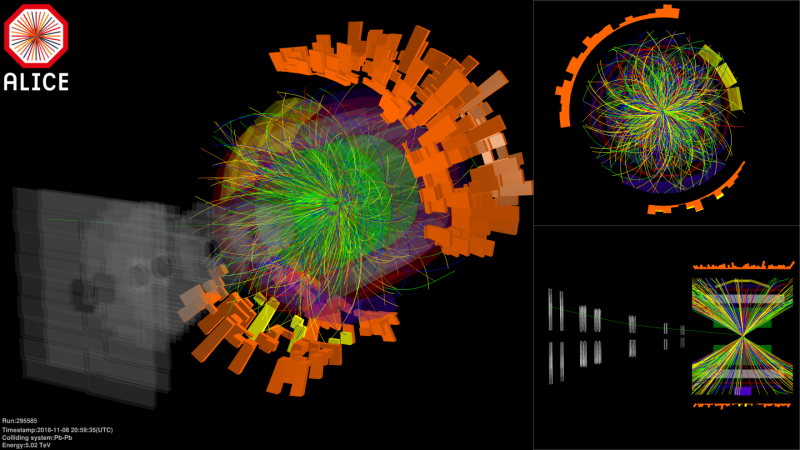This time it's done, after three years of maintenance shutdown, the LHC, the giant particle collider at CERN near Geneva, has restarted. 100 meters underground, in its 27-kilometer ring, protons are once again being accelerated in both directions at close to the speed of light, before being thrown against each other in the four detectors - ALICE, ATLAS, CMS, LHCB - placed along their path. The result is a concentration of kinetic energy which, by virtue of the equivalence between energy and mass, is transformed into jets of particles that reveal the processes at work in the intimacy of matter.
After a major upgrade of the LHC facilities, the energy and frequency of the collisions have been increased, as has the capacity of the detectors to collect the ouput. Thus, at the end of this new four-year run, the scientists who operate the Geneva-based colossus will see the quantity of data at their disposal triple. This will allow them to explore a little further the fundamental laws of our Universe, on which the history of the cosmos and that of all the matter it contains depend.
More precisely, run 3 of the LHC is the continuation of a formidable scientific adventure that began 12 years ago with the commissioning of the accelerator. At the time, the scientists' main objective was to discover the existence of the Higgs boson. Higgs Boson? According to the current theory of the infinitely small, the Standard Model, elementary matter is composed of particles of matter that interact by exchanging force particles. Developed between the 60s and 70s, this "model" has seen all its predictions verified. All except one: the existence of an additional particle, the famous boson, which is supposed to give mass to particles that have mass. The colossal energy brought into play in the LHC collisions was to finally allow the Higgs to be extracted from the corners of space-time where it was hiding. And indeed, in 2012, 48 years after a handful of theorists had predicted its existence, the experimentalists of the ATLAS and CMS experiments discovered the famous Higgs boson. The discovery, rewarded by a Nobel Prize in Physics in 2013, completes the construction of the Standard Model.

Ten years ago, the ATLAS and CMS collaborations announced the discovery of the Higgs boson. The images show candidate events for the Higgs boson from collisions between protons in the LHC. On the left, an event obtained by the CMS experiment shows a two-photon decay (yellow dashed lines and green lines). On the right, an event obtained by the ATLAS experiment, shows a decay into four muons (red traces). Credits: CMS/ATLAS/CERN
However, since the conception of the LHC, matter specialists have assigned it another mission: to put them on the track of a new physics, or "non-standard" physics, not described by the Standard Model. In fact, between dark matter, the absence of antimatter in the Universe, the acceleration of the cosmic expansion, formal inconsistencies... they have known for decades that their representation of the laws of the infinitely small as well as of the infinitely large is incomplete. And that is the challenge of run 3: to allow physicists to finally sketch the contours of a new physical continent that has remained totally unexplored until now. We are entering a phase of exploration of the unknown," says Marie-Hélène Genest, a researcher at the Grenoble Laboratory of Subatomic Physics and Cosmology and a member of the ATLAS experiment. “We are not sure of anything, except that run 3 will allow us to make very beautiful measurements with unprecedented precision.”
In concrete terms, this exploration will take multiple complementary paths, in particular with the ATLAS and CMS experiments known as "generalist" experiments. The first is to look for traces of unknown particles in the batch of particles that appear during collisions between protons. No such observations were made during the previous runs. "Because of the slightly higher energy involved in the collisions [from 13 to 13.6 TeV], the probability of producing rare and interesting events will increase by 20% to 250% depending on the mass of the particles," explains Marie-Hélène Genest. Moreover, thanks to the greater statistics that physicists will have at their disposal at the end of the campaign, it is not impossible that more massive particles and/or particles with lower production rates than those accessible up to now will appear.
Moreover, through renewed detection and analysis strategies, scientists are considering the possibility of very light particles that would have remained "under their radar". Finally, they will be looking for long-lived particles which, decaying therefore far from the interaction point, have their products more difficult to identify.
According to theoretical speculations, some of these possible particles are candidates for the resolution of the enigma of dark matter, which has remained invisible, but which astrophysicists think they observe gravitational effects at all scales of the Universe. Others would be the sign of new symmetries to which the most fundamental laws would obey, or of the existence of additional dimensions of space. In any case, as Marie-Hélène Schune, from the Irène Joliot-Curie Laboratory and member of the LHCb experiment, explains, "in a period when Experiment must serve as a guide to sort out the very many approaches proposed beyond the Standard Model, our strategy will be to look in all possible directions without referring to any particular theory.”
In particular, beyond the observation of new particles, the scientists will track down possible deviations from what the Standard Model predicts in different particle decay channels with a magnifying glass. As Marie-Hélène Genest explains, "these deviations could indeed be a sign of the existence of non-standard particles that are too massive to materialize at the LHC, due to lack of sufficient energy, but which nevertheless make their virtual influence felt in the quantum processes accompanying the collisions."
In this regard, all eyes will be on the LHCb experiment designed to study the decay of particles called B mesons that contain a b quark or its antiparticle. Indeed, data recorded during previous runs have revealed several "anomalies" in the way some b mesons decay into either electrons or muons. According to the Standard Model, the two processes should be perfectly equivalent. But this is not the case. Also "non-standard" angular distributions in the way some decay products of these particles are emitted have been observed. "At this time, these discrepancies are not yet statistically significant enough to conclude, but they could become stronger and end up drawing a coherent landscape in favor of an unknown physics," enthuses Marie-Hélène Schune.
The precise study of the properties of the Higgs boson will also be one of the priorities of run 3. In runs 1 and 2, the experiments revealed how the particle interacts with the top and b quarks, as well as with the tau lepton, and the W and Z bosons that carry the weak interaction. Among other things, scientists now hope to begin comparing its rate of decay into a pair of tau leptons with that of decay into a pair of muons.
As Yves Sirois, from the Leprince-Ringuet Laboratory and member of the CMS experiment, explains, this measurement touches on one of the greatest mysteries of matter: "We observe that the particles of matter are organized into three perfectly identical families without knowing why. More precisely, the particles of the different families are distinguished only by their mass, i.e. by the way they interact with the Higgs. Thus, a possible discrepancy between the way the Higgs decays into muons or taus, two particles that play the same role within their respective families, could put us on the path to understanding why the physical Universe seems to have three identical copies of itself."
In the field of the Higgs, run 3 will also allow the first measurements of the particle's interaction with itself. In doing so, physicists will begin to study the properties of the Higgs field, the quantum entity from which the boson of the same name is extracted during collisions in the accelerator, and which bathes the entire Universe, giving its structure to the vacuum and its mass to the particles. “There is a deep link with the history of the Universe," explains Yves Sirois. “Indeed, we know that just after the Big Bang, the particles had no mass, which means that the Higgs field had a different structure. Did it evolve everywhere at the same time in the Cosmos, or did it grow in larger and larger regions? We don't know, just as we don't know whether the Higgs field, in its present structure, is definitely stabilized or not.” The beginning of a possible answer at the end of run 3.
The links between the infinitely small and the infinitely large will also be the focus of the ALICE experiment, whose detector is dedicated to the study of the quarks and gluons plasma (QGP). Obtained by colliding lead nuclei, this is a kind of "soup" of ultra-hot and dense matter in which quarks and gluons, usually bound to each other, are free to move. The QGP is essential to study in detail the properties of the strong interaction, the one that structures atomic nuclei in particular. It also corresponds to the state in which cosmologists believe the Universe was a few microseconds after the Big Bang.
Impossible to observe directly, the QGP reveals itself through the myriads of particles that it ejects within the detector as it cools and as the elementary matter that composes it reorganizes. As Stefano Panebianco, from the Institute for Research on the Fundamental Laws of the Universe at CEA Paris Saclay and a member of ALICE, explains, "During runs 1 and 2, we focused on the most common particles emitted by the plasma, such as protons and neutrons, as well as some characteristic resonances.” Thus, the researchers obtained several spectacular results, by demonstrating in particular that the plasma of quarks and gluons behaves like a liquid whose viscosity would be almost zero. But with the results of the last three years, "we will have access to probe particles containing heavy quarks, both produced in small numbers and with exotic decay modes, which will finally allow us to describe the properties of these probes in more detail and in a more selective way," continues the researcher.
This should provide an answer to the question of what is the deep nature of the transition that sees the burning plasma turn into ordinary matter when the temperature decreases. "This is very important for constraining models of the history of the Universe and extrapolating them back to the Planck era, when the Cosmos, just out of the Big Bang, was still just a mush of quantum particles," says Stefano Panebianco.
Like their colleagues at the LHCb experiment, whose experiment is sensitive to the asymmetry between matter and antimatter, the ALICE scientists also imagine that they can provide clues to help understand why the Universe is completely empty of antimatter. For a century, this enigma has been a nagging question, even though the equations of the standard model indicate an almost perfect symmetry between matter and its nemesis. This makes run 3 a great opportunity to challenge the LHC with the greatest mysteries of the infinitely small and the infinitely large.
Translated from an article written by Mathieu Grousson (les Chemineurs), published here



